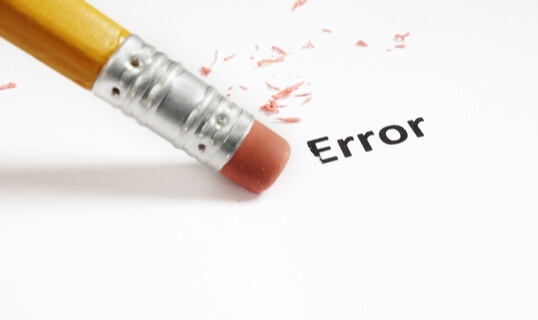When to Destroy Your Marketing Materials. Skip the Garbage Can; Please Recycle If You Can.
April 18, 2019

 Poor grammar, spelling mistakes, and typos don’t leave a good impression.
Poor grammar, spelling mistakes, and typos don’t leave a good impression.By Maureen McCabe
Over the past twelve years, our team has worked with many clients. Despite our recommendations, a few chose to save money over destroying marketing materials whether they were outdated or had printing errors due to inadequate proofreading.
If you have re-branded (new logo etc.) please throw out your existing marketing collateral — from brochures, stationery, to business cards, and more. It’s okay to use them internally — but only as scrap paper. Even that can be challenging if staff use the old stationery by accident.
Best Practices: Do not send anything to a customer that will be printed (whether on your printer or by a printing company) that you have not approved and proofread. If you are paying to have the item printed, don’t delegate it to someone — do it yourself.
The best tip from a professional proofreader
In 1993, I got advice from a professional proofreader who worked at a large Canadian agency. Helena learned how to proofread in the late 1960s by a well-known editorial team at a Canadian national magazine. Her hourly fee was $150 per hour. (*)
TIP 1: Use a credit card and read the text backwards.
(*) NOTE: We have a professional editor on our team who has eagle eyes and charges a fraction of the big agency fees in downtown Toronto.
After a professional had proofread and approved the ‘proofs’ of an IBM brochure, I caught two minor errors. Although neither was significant in my opinion — copyright and trademark errors (even in a tiny font in the footer known as “mice type”) — they certainly mattered to the IBM legal department.
Typically, they asked to see the proofs before printing which often caused unnecessary delays in an already tight schedule. Every time we printed marketing collateral the IBM lawyer received a sample — it was our process. In this case, it was trust and credibility. I did not want to be the marketer who caused them to change their flexible policy.
How I proofread — online and print
You cannot rely on “tools’ to proofread each document exclusively. For editing and proofreading, you can use Microsoft’s spell check and grammar or apps such as Grammarly. The paid version uses an algorithm which flags potential issues in the text and suggests context-specific corrections for grammar, spelling, wordiness, style, punctuation, and plagiarism.
I find more errors by proofreading a hard copy although some documents can only be proofread online.
The tailor’s proverb, “measure twice, cut once” applies to a proofreader, constantly review it twice before it goes to print.
TIP 2: Stand up and read aloud — I imagine that I’m a politician giving a significant televised address and even state the punctuation!
When I had a 15-page report to proof and needed to review it a second time on the same day, I needed another technique to stay alert to ensure accuracy. As a former Toronto vocal music school teacher for grades kindergarten to eight; you don’t have to be a trained singer to try the following.
TIP 3: Stand up and sing every syl-la-ble — sometimes with drama or theatrics
Imagine your radio personality, actor, or a high school teacher that you liked, whatever captures your imagination. Try it, and I bet you’ll have fun!
You’ll be surprised by the number of errors you will identify by using the above three tips.
Examples of what should have been recycled, and another that could be used despite a typo:

My role as a marketing consultant is to provide clients’ recommendations with the rationale. They decide to implement the recommendations or ignore them. Fortunately, 95% listen to the advice as they know I always have their best interests in mind.
1. Referral Card — typo
A client that provides a high-end service costing several hundred dollars per visit continues to distribute a referral card with an error.
Although the owner understands that his brand will be diminished, he doesn’t perceive it as significant. He is not willing to throw them out.
2. Letter — grammar and formatting errors
Another client, a chiropractor wrote a letter and printed it on stationery — himself.
There were formatting and grammar errors — it wasn’t well written. When I commented on this mid-way through the mailing to 2,000 patients, he said he didn’t want to waste the money to use more letterhead. He had lots in stock, could have printed it on the laser printer, and it would not have impacted the schedule.
Was his professional brand hurt? Yes. Did it impact his sales? We’ll never know who didn’t come in the door.
3. Envelopes — rebranded
An established business had rebranded they loved the new marketing materials, website and stationery. My problem was with the penny-pinching finance guy who refused to use the new #10 window envelopes for mailing invoices.
He liked that we had printed the window envelopes in black because it was economical, unlike the previous ones and said his team would use them.
Imagine my shock when I received my cheque in the old envelope.
When I saw the bookkeeper, I jokingly asked if she were teasing me. She said no, “we must use all of the old ones first” and showed me a storage cabinet with over 5,000 envelopes which she estimated was a three to four-year supply!
I asked a Vice President about this, and he said that the same thing the finance people refuse to recycle the old ones. The next time I saw him, I shared my solution. I’m not at liberty to disclose exactly what we did to get the finance person to use the new ones. Let’s say they ran out quickly as he seldom checked the supply cabinet.
4. Sticker — too small to read
I’ve shared this story since 2011 and blogged about it in January 2012. Suzanna is not a client.
She had an impressive double-sided business card printed on premium card stock which included her logo, company name, website, email, phone number, address, first and last name, and social media. In 2010, Suzanna embraced social media and was active on Facebook, LinkedIn, and Twitter; she was ahead of her competitors and most businesses.
Suzanne wouldn’t give her card to anyone. Why? Her name was spelled with only one “n” — Suzana. She blamed the graphic designer for the error — not her proofreading — if she had, it could have been edited before Suzanna gave it to her printer. Suzanne could have asked the designer to edit the file for future use; she did not.
Three days before her cupcake deal on Groupon launched.
A friend brought me to her bakery hoping Suzanna would heed professional advice. I saw the tiny 1.5″ label that she designed for her boxes. Suzanna believed the sticker would generate dozens of new long-term customers — honestly, I’m not fibbing!
It was so small that I could read neither the company website nor phone number without a magnifying glass. I’m not exaggerating — well, maybe a little. Suzanna choose a small sticker size because,
“It’s much cheaper than larger circular and horizontal ones. Plain and simple, I designed it myself to save money and avoid errors. I used my printer.”
When it’s okay to use a business card with a typo.
In the scheme of things, missing the “n” in her first name was less important than getting the business name and contact details out.
How many people would think it was a typo? That’s why I recommended that she give a card to every Groupon purchaser, remember the sticker was not readable. Did she expect people to peel it off or log into their Groupon account to get her store address? Suzanne still had her 2,000 business cards from 2010 which she failed to have corrected and reprinted.
Getting a new card printed using similar premium card stock or a lower quality but professional looking stock to save money – and on the reverse – offer a 20% discount to encourage repeat sales from Groupon customers was brushed off. The Printing House can design or recreate a business card and deliver it within a couple of days.
She shrugged with the suggestion of creating a flyer with a 25% discount to get repeat sales.
Ideal Client, Not!
Her hair dresser felt Groupon was a quick and easy way to get more customers, although Ricardo hadn’t used it for his salon, he had bought coupons from another site. One of Ricardo’s customers had told him Groupon was a more popular website.
Suzanna knew it all – she didn’t need to evaluate the actual cost – both time and money.
She wasn’t open to create a plan to leverage her deal or do a post mortem for lessons learned. Suzanna disagreed about using the old business card, getting a new one with a special offer, or creating a flyer.
Because she was close-minded and thought repeat sales would happen automatically. I knew she wouldn’t be an ideal client.
My friend dropped by the bakery a few months later; Suzanna expressed disappointment by the lack of repeat sales – are you surprised? Yep, she didn’t heed the advice of yours truly, a marketing professional who had experience with Groupon.
Learn how to minimize one-time purchases from Groupon customers.
A marketing plan is critical for any discounted “daily deal” website such as Groupon and WagJag. Firstly, you need a strategy to determine if your product or service would generate repeat sales and how to do it.
Did you know that the business owner only gets half of the money from the coupon? Learn what to and not do; check out my Groupon post to learn more.
The bottom-line
You have worked hard to establish and maintain your brand, professionalism, and reputation. Do poor grammar, spelling mistakes, or typos leave a good impression? Is this the way you want prospective customers to see your business? Likely not.
Learn to destroy outdated brochures and marketing collateral with errors. The cost of reprinting is relatively inexpensive compared to the cost of maintaining your brand and professional image.
Please skip the garbage can and recycle if possible.
Looking for cost-effective ways to promote your business?

Marketing Companies Toronto | Marketing Agency Toronto
- Marketing Services
- What We Do
- 10-hour Starter Package
- Marketing Strategy
- Marketing Plan
- Attract & Keep Customers
- Website Marketing
- Promotional Marketing & Ads
- Online Video Marketing
- Branding
- Marketing Materials
- Marketing Tools
- Why Choose Us
- Maureen McCabe, Small Business Marketing Consultant
- Small business marketing Toronto
- Help You Grow
- Video Gallery
- Marketing Fees
 Free Consultation
Free Consultation Marketing Check-up
Marketing Check-up Free Marketing Report
Free Marketing Report Free SEO Template
Free SEO Template Make An Inquiry
Make An Inquiry



